
19 minute read
The Stunning New H4 Series Hidromek 390LC
view from the cab THE STUNNING NEW H4 SERIES HIDROMEK 390LC CRAWLER EXCAVATOR
Thought to be one of the first, if not the first, in the UK, this new generation H4 Series Hidromek crawler excavator is now earning its keep at the Johnsons Wellfield Quarry on the outskirts of Huddersfield, as Plant & Civil Engineer’s David Stokes reports.
There’s no doubt this latest generation Hidromek 390LC H4, supplied through Bunton Plant, is a real eye-catcher. Replacing the earlier 370LC model, this new machine is busy working at the famous Wellfield Quarry in the Yorkshire Pennines. Johnsons Wellfield is Britain’s leading supplier of natural hard Yorkstone. With extensive reserves of the finest ‘Crosland Hill’ Yorkstone available combined with state-of-the-art industry leading processing facilities, Johnsons Wellfield has grown to become the supplier of choice for prestige projects where only the best will do. Established in 1854 the famous Wellfield Quarries came into Johnson’s ownership in 1928 and was acquired by the Myers Group some 50 years later. Investment has continued under Myers Group stewardship and the business is now at the forefront of the UK stone industry, producing in excess of 60,000 square metres of dimensional stone on an annual basis; the quarry extraction site currently covers an impressive 250 acres of West Yorkshire hillside. This stunning looking Hidromek 390LC H4 is certainly a big step up from the machine it has replaced, featuring as it does much smoother and sharper lines and a brand new upgraded, restyled cab that offers an excellent working environment for the operator. “Although it is a relatively new brand in the market here, we didn’t have any reservations about acquiring the new Hidromek as an addition to our fleet as we have operated several smaller models at the quarry last summer, so we knew what to expect and it hasn’t disappointed,” says quarry supervisor Phil Rogers.
Robust & Responsive
“The machine, which is currently being used to feed a crusher, has plenty of power, it is very responsive on the hydraulics; we are very pleased with its robustness, reliability and performance.” It is powered by the latest fuel efficient Isuzu-AQ-6HK1X, water-cooled, six cylinder electronic diesel engine, producing net 282hp@1900rpm, with maximum net torque of 1043Nm@1500 rpm, and complying with Tier 4 final and EU stage IV emission regulations. “We have noticed that it is very easy on fuel, even though we work it long and hard,” adds Phil, “so it is both productive and efficient.”
Spacious Cab
While it certainly looks the part, it is inside the cab that the real difference can be seen in comparison to the earlier 370LC model. Features include a relocated switchboard, remodelled travel pedals and levers, high capacity air-conditioning and high resolution, LED backlight colour LCD display. With a cab door that is large enough to enable the operator to open it easily, while providing


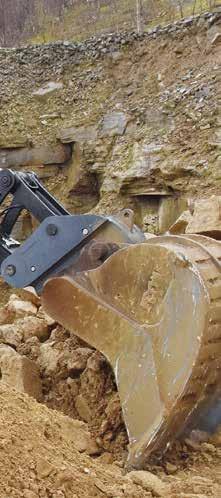

plenty of clearance, the machine benefits from an improvement in all round visibility, with LED headlamps also significantly enhancing its night vision capacity, as does the addition of a rearview camera. It is also possible to open the windscreen by sliding it towards the roof, and the lower Window may be removed and kept under the operator seat. Other features enhancing the operator’s comfort is the new versatile and fully adjustable seat designed to enable operator to work without stress and fatigue for longer hours. The joystick console and seat can move independently enabling operator to adjust the most suitable position for his body structure; the seat is equipped with seat belt for safety of the operator. The cab is supported by six silicon viscose mounts that dampen the effects of noise, shock and vibrations regardless of working conditions of the machine. There’s plenty of storage space, too, for the operator’s bits and pieces, including a cooled storage room, glass holder and a variety of storage pockets. “We have no complaints about the cab. There’s plenty of space and comfortable seating, with excellent visibility, and once you get used to the various controls, it provides an excellent, stress free working environment,” says Phil.
Opera Control System
This new 390LC H4 is also fitted with Hidromek’s Opera
Control System, an easy to use interface that facilitates communication between the operator and the machine. The operator can easily switch between menus in Opera, change settings, such as hydraulic flow, and check the status of the machine, including pressure, temperature and engine load. The information and warnings on the instrument panel are always easy to see and control, thanks to the positioning of the Opera interface. Other features of the system include automatic powerboost switchon switch-off, automatic electric power-off and automatic powershift to improve performance. Dealer support is also important, and Bunton Plant doesn’t disappoint. “From experience, we have every confidence that if we ever need their service they are just a phone call away and will respond very quickly, appreciating that we can’t afford unnecessary downtime on site.”

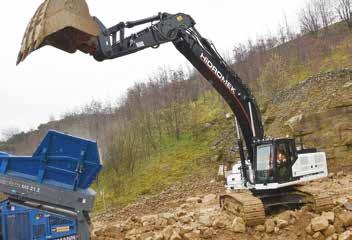
CATERPILLAR UNVEILS NEW INNOVATIVE RANGE OF MINI EXCAVATORS
Caterpillar certainly isn’t resting on its laurels, nor is it standing still. It has just launched a new range of small - and slightly larger - mini excavators, as Justin Carrigan reports from sunny Malaga.
There are five new models in the Cat ‘small’ mini hydraulic excavator line-up, covering the 1-to-2-ton class categories. They incorporate a host of industry-first standard features, such as joystick steering (stick steer) and a tilt-up canopy or cab, as well as new options, including air conditioning and expandable undercarriages across the range. The new model range allows customers expanded choices for matching machine capabilities and machine features to the applications: 301.5 (1.5-ton class, standard tail swing, with canopy); 301.6 (1.5-ton class, standard tail swing, with cab); 301.7 CR (1.7ton class, compact radius, with canopy); 301.8 (1.8-ton class, standard tail swing, with either canopy or cab); 302 CR (2.0-ton class, compact radius, with either canopy or cab). Minimum operating weights (approximate) for the new models range from 1575-2045 kg, with weights increasing to 1760-2200 kg, depending on specific machine configuration. Dig depths are 2340 or 2370 mm, depending on the model, and an available long stick increases depth to 2540 or 2570 mm. Rubber track undercarriages are standard, with steel tracks available for all models. All the new models use the Cat C1.1 engine, a three-cylinder diesel rated at 14.3 net kW (19.2 net hp), available in configurations that meet EU Stage V emission standards. The C1.1 features a power-dense design and delivers consistent performance through a wide speed range. Fuel efficiency is enhanced with engine idle control and automatic shutdown systems.
Premium features
These Next Generation mini excavators use an efficient, fuel saving, load-sensing hydraulic system with an electronically controlled variable displacement piston pump capable of oil flows to 66 L/min (17.4 gpm). Flow rates, coupled with high main-relief pressures, provide the new models with the hydraulic capacity to generate high digging and lifting forces, as well as to handle powered attachments. For added versatility, the standard auxiliary hydraulic system (complete with quick disconnect lines) provides one way, two-way, and continuous flow. Manual couplers, a



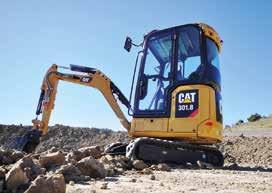

thumb-ready package, and a certified lifting eye are available for all new models. Front shovel operation, a capability that lends an extra measure of precision when digging around utilities, can be accomplished with both pin-on and coupler-mounted buckets.
Operator environment
The design of the new Next Generation models emphasises the comfort, convenience, and safety of the operator. The cab, standard on the 301.6 and optional on the 301.8 and 302 CR, is pressurised and sealed to reduce dust intrusion and is fitted with a climate control system (with or without air conditioning). The front window slides upward and stores overhead, and large glass areas on the sides and rear of the cab, plus a skylight, provide all around visibility. The operating consoles feature adjustable wrist rests, and a suspension seat is available. A retractable, wide seatbelt is comfortable to wear. Controls are designed to be intuitive, with a pattern changer that allows operators to select their preferred system. A machine security system is standard, available as key with pass code or push-to-start with fob. The Next Generation LCD monitor provides easy-
to-read machine information and features a jog dial for easy, ergonomic interaction with the monitor. The machines can also be Bluetooth enabled through the radio. An exclusive feature for the new Next Generation models is the standard stick steer system, which allows the operator to switch (with the touch of a button) from conventional lever/foot-pedal steering controls to left-hand joystick control. Stick steer provides the benefit of less effort with improved operator control. Additionally, automatic two-speed travel is standard.
Moving on Up
Meanwhile, Caterpillar has also added six new mini models in the 7-to-10-ton category, with many of the same features of their smaller ‘sisters’, and also including heavy duty main structures, fuel efficient engines, load sensing hydraulics, spacious cabs, and the exclusive Caterpillar stick steer system. The new model line-up includes the 307.5, a standard tail swing model with a fixed boom; 308 CR, a compact radius model with a swing boom; 308 CR VAB, featuring a variable angle (two-piece) swing boom; 309 CR, a new model in the mini range
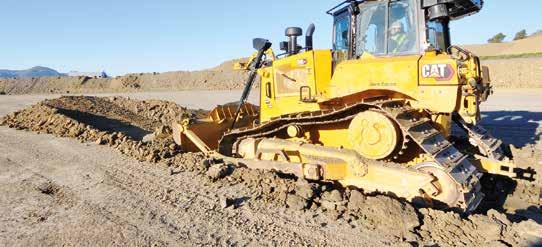

featuring a compact radius, swing boom, and “high flow” auxiliary hydraulics; 309 CR VAB, which expands the 309 CR’s capability with a variable angle boom; and 310, also new to the range, featuring a fixed boom, standard tail swing, and twin blade cylinders for handling heavy duty dozing chores. The new models range in maximum operating weight from 8 233 to 10 182 kg in standard dig depths from 4 107 to 5 174 mm. Three models—307.5, 308 CR, and 309 CR—are available with a long-stick option that increases dig depth by approximately 560 mm. The variable angle boom, available with the 308 CR VAB and 309 CR VAB, enhances digging capability in congested work areas. Powering the 307.5 is the Cat C2.4 turbo diesel engine rated at 41.7 net kW (55.9 net hp); the five larger models use the Cat C3.3 diesel engine rated at 52.4 net kW (70.3 net hp). The six new models are also fitted with cabs, sealed and pressurised to ensure a clean environment, and feature a redesigned heating/ventilating/air conditioning system that ensures all-weather climate control. Suspension seats, with a retractable, wide seatbelt are standard, and the operating consoles feature adjustable wrist rests. Intuitive controls include the Next Generation LCD monitor that provides easy-to-read machine information and features a jog-dial for easy navigation, including setting personal operating preferences. For added convenience, a standard control-pattern changer allows operators to quickly adapt the machine to their favoured joystick movement. A machine security system is standard, available as key with pass code or push-to-start with fob. The machine can also be Bluetooth enabled through the radio.
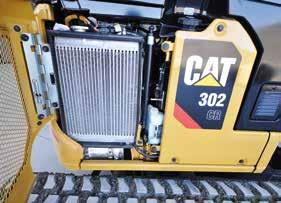


CASE CX300D FITS THE BILL PERFECTLY AT ROBINSON CONCRETE

When Robinson Concrete needed to replace an excavator that had given many years of reliable service at their sand and gravel business, they thought long and hard about it, and then took lots of advice on what brand to invest in.
Eventually, they decided on a Case CX300D from dealers Cowan Bros. That was four months ago, and they haven’t looked back since as Plant & Civil Engineer’s David Stokes discovered when he got the ‘view from the cab.’ Established in 1951 by Matthew Robinson, Robinson Concrete has developed from its humble origins in Claudy and Dungiven to fulfil the need for agricultural, housing and road development following the Second World War. A family business, now in its third generation, it prides itself in being at the forefront of concrete products’ supply in the North West, operating two strategically located depots in Claudy and Ballymoney, both equipped with facilities for the collection or delivery of ready mixed concrete, blocks, sand, gravel, decorative stone and landscape products. The CX300D excavator is the company’s first Case and it is more than living up to expectations, as Garth Robinson explains: “It has replaced with a 15 year-old 20 tonne machine that has given us great service, so we were very cautious about what to get. “We wanted to upgrade to something a bit bigger and as our company is a supplier to Cowan Bros, the Case brand was obviously on our list of choices. Not only do Cowan Bros have a good reputation in the industry, but so does the Case – we heard great reports about them - so we went along to see what they had to offer.” Adds Gareth: “They invited us up to Fermanagh to see a Case machine at work; we spoke to the operator who had many years of experience working with a variety of excavators and in his words the Case

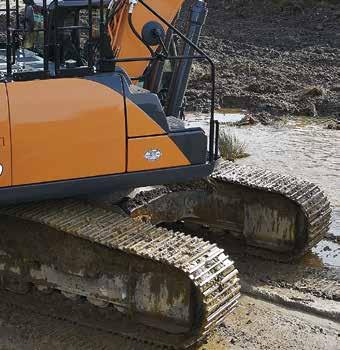
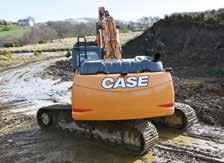
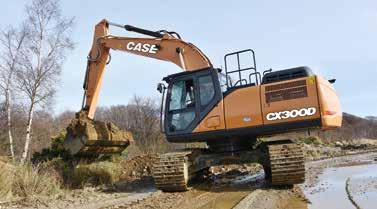
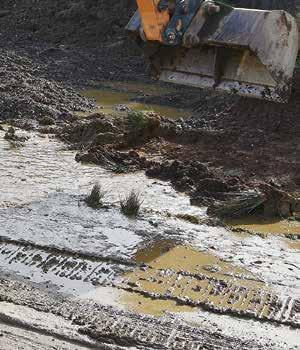
was ‘the best 30 tonne machine that he had ever driven.’ “So, we returned home and gave the matter some more serious thought, eventually deciding to take the plunge; it’s a decision that we haven’t regretted. Cowan Bros were excellent throughout the process; in fact, the machine was delivered within six or eight weeks of us placing the order.”
Fuel Efficient
So, what is the appeal of the Case CX300D? One of the first things Gareth noticed about it was its fuel efficiency. “Being a bigger machine than the one it replaced, it is using a lot less fuel than the 20 tonner.” Indeed, the CX300D is powered by an Isuzu six-cylinder engine that uses an SCR Tier 4 Final solution that’s cleaner burning and provides up to 14% increased fuel efficiency without sacrificing power. As do all models in the D Series, the CX300 has three power modes to match different application needs, improve cycle times and further maximise fuel economy - Automatic (A) for the best balance between power, precision, and fuel efficiency, with Power Boost continuously engaged; Heavy (H) for increased RPM for faster cycle times in general loading; and Speed Priority (SP) for maximum RPM and hydraulic flow providing the fastest cycle times and maximum flow for demanding attachments. D Series excavators have a new electronically controlled hydraulic pump, a larger control valve and a new solenoid valves. These upgrades help boost breakout force, increase lifting strength and improve responsiveness, which enables the machine to work faster throughout the work cycle. In fact, cycle times are up to 12% faster than the C Series excavators. The standard Free-Swing feature allows the carriage to spin freely while operating the boom and arm, which provides improved control.
Comfortable Cab
Operators particularly like the Case cab which offers an excellent working environment. “If you are operating the machine over long hours, you need a bit of space and comfort, and the Case cab doesn’t disappoint,” says Gareth. Case have upgraded and improved cab over earlier models. There’s more entry room and foot space. The air-ride seat is larger to reduce pressure points, slides forward and back, tilts back up to 65°, has an adjustable lumbar system and a built-in heater. An innovative armrest design adjusts independently of the console while still ensuring joysticks are always comfortably within reach. Even the pedals can adjust ±22° to suit personal preference. There’s also a Bluetooth radio and climate control system that responds to sunlight. An optically bonded, anti-glare 7-inch LCD multi-function monitor displays an abundant amount of machine operating data as well as setup and servicerelated screens. Press a button and get up-to-date information on fuel level, temperature and pressure valves. Another button provides information on hours and fuel usage for up to two trips. Working on busy sites requires the operator to have a clear view of what’s happening around the machine, and again the CX300D hasn’t fallen short in that regard. It offers outstanding visibility from the operator’s seat, utilising standard rear and side view cameras. Also available is an optional 270-degree CASE Max View display for extra perspective while operating, something all operators would appreciate when working long days. The Case also offers a quiet working environment, thanks to a cushioning system that lowers noise and vibration levels – and there’s ample legroom along with a spacious storage compartment and warm and cool box.
Serviceability
The CX300D features standard oil sample ports to allow for quick sampling of engine oil and hydraulic oil while grouped service points, tilt-out coolers and autolocking side panels that stay open make it easy to perform routine maintenance. There are even new handrails to make it easier to get around the machine.

news Campaign to tackle plastics and packaging in construction
The Considerate Constructors Scheme has launched its industry-wide campaign ‘Spotlight on...plastics and packaging’ to raise awareness and showcase best practice in how the construction industry can reduce, reuse and recycle plastics and packaging.
The launch of the campaign - which features on the industry’s Best Practice Hub - comes in response to startling findings from a Scheme survey of over 900 people working within the UK and Irish construction industries. The survey discovered that although over 95% of respondents said the industry needs to be doing something to reduce its consumption of plastics and packaging, over half of respondents (51%) have little understanding of the rules and regulations surrounding plastics and packaging, and only 44% know how to recycle different plastic and packaging materials. The survey also revealed that: • 98% said the over-consumption of plastics and packaging is a global issue. • 92% believe plastics and packaging are extremely dangerous to the environment. • 81% said the construction industry is not doing enough to reduce its consumption of plastics and packaging. • 31% said they frequently use plastics and packaging that cannot be reused or recycled. With the construction industry being the second largest consumer of plastics in the UK, it is imperative that the construction industry reconsiders the way it consumes and disposes of plastics and packaging to protect the environment and all life. The Scheme is calling on all construction sites, companies, suppliers and clients of construction projects to drastically reduce their consumption of plastics and packaging. Not only does this offer significant improvements for the environment and society as a whole, it also makes commercial business sense, with many organisations reporting significant cost savings achieved. ‘Spotlight on…plastics and packaging’ provides a suite of resources to help the industry to address this issue. It includes a range practical case studies and guidance from contractors, clients and service suppliers. Considerate Constructors Scheme Chief Executive, Edward Hardy said: “As construction is the second largest consumer of plastic in the UK, our industry has one of the greatest responsibilities to society, and to the environment, to ensure that we are working tirelessly to improve our standards in minimising waste from plastics. “The Scheme’s ‘Spotlight on…plastics and packaging’ campaign provides resources, practical support and guidance helping everyone to take effective measures to tackle this issue. While considerable progress is being made – with over 76% of Scheme-registered construction sites setting targets to reduce, reuse and recycle waste – it is clear that a concerted effort to raise further awareness, and to provide the necessary support, is needed to achieve this drastic reduction in waste from plastics and packaging.”
Ireland West Airport announces delivery team for rehabilitation of airport runway
Ireland West Airport has awarded the main construction contract for the rehabilitation of the airport’s runway to a joint venture comprising specialists in this area, Lagan Airport Maintenance, and Clare Civil Engineering Company Ltd, known as LCJV.
The appointment of the contractors follows their successful joint bid under an EU tender process. This design and tender process was led by Atkins Ireland following their appointment by Ireland West Airport as specialist consultants in 2018. The project will cost €11.2m and is supported to the value of 75% of the total by the Department of Tourism, Transport and Sport with the airport funding in the region of €2.8m from its own funds to complete the project. Preparatory works will begin immediately with main resurfacing works scheduled to start in May. The rehabilitation of the runway, which includes a complete resurfacing of the existing runway and taxiway surfaces, the removal and reinstatement of runway edge, centre line, and touch down zone lighting, ducting and other associated works. These works are scheduled to ensure that the runway at Ireland West Airport continues to meet the strict regulations governing the operation and specification of runways at major airports. Runway 26/08, which opened in 1985 handles 100% of all flights at the airport and this is the first time in its 34-year history that the runway has had a full overlay. This resurfacing works will take place overnight outside of operational hours over a threemonth period. This work can only be undertaken at night as it requires the full closure of the airport’s main runway. Upgrading the main runway is a complex logistical project as construction teams will overhaul a portion of the runway every night before it’s handed back to operations early each morning in time for the first wave of flights into the airport. The window for construction is only about five/ six hours per night due to the set-up process required and the meticulous preparations for returning the runway to normal operations every morning.
PLANT & CIVIL
GOLF MASTERS
THURSDAY 29th AUGUST 2019
The Faldo Championship Golf Course at Lough Erne Resort
Contact Phil on 028 9268 8888







